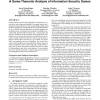Free Online Productivity Tools
i2Speak
i2Symbol
i2OCR
iTex2Img
iWeb2Print
iWeb2Shot
i2Type
iPdf2Split
iPdf2Merge
i2Bopomofo
i2Arabic
i2Style
i2Image
i2PDF
iLatex2Rtf
Sci2ools
WWW
2008
ACM
2008
ACM
Secure or insure?: a game-theoretic analysis of information security games
Despite general awareness of the importance of keeping one's system secure, and widespread availability of consumer security technologies, actual investment in security remains highly variable across the Internet population, allowing attacks such as distributed denialof-service (DDoS) and spam distribution to continue unabated. By modeling security investment decision-making in established (e.g., weakest-link, best-shot) and novel games (e.g., weakest-target), and allowing expenditures in self-protection versus self-insurance technologies, we can examine how incentives may shift between investment in a public good (protection) and a private good (insurance), subject to factors such as network size, type of attack, loss probability, loss magnitude, and cost of technology. We can also characterize Nash equilibria and social optima for different classes of attacks and defenses. In the weakest-target game, an interesting result is that, for almost all parameter settings, more effort ...
Internet Technology | Security Investment Decision-making | Security Keywords Economics | Versus Self-insurance Technologies | WWW 2008 |
| Added | 21 Nov 2009 |
| Updated | 21 Nov 2009 |
| Type | Conference |
| Year | 2008 |
| Where | WWW |
| Authors | Jens Grossklags, Nicolas Christin, John Chuang |
Comments (0)

